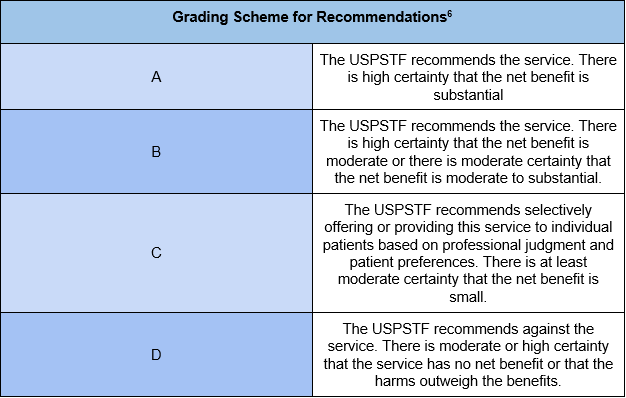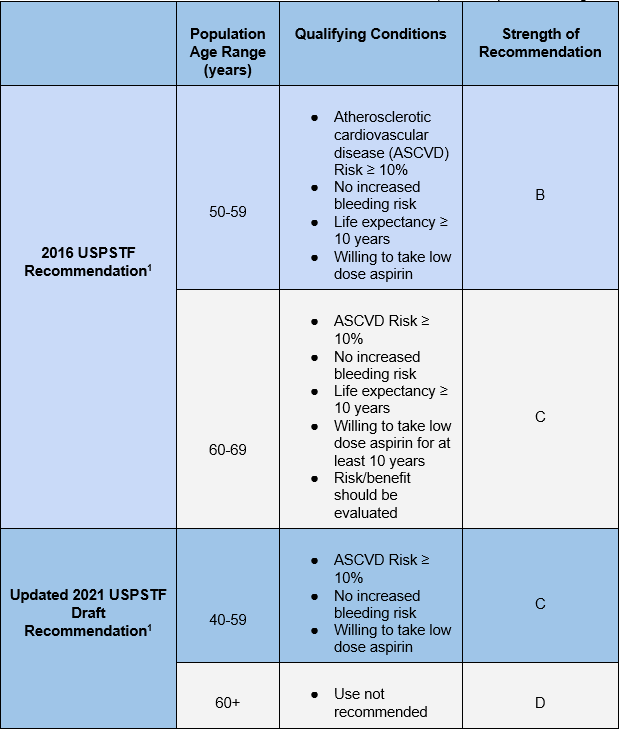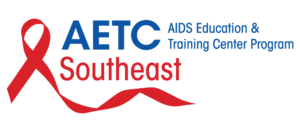
A Change of Heart: 2021 Updates to Aspirin for Primary Prevention
By: Brittany Chen, PharmD Candidate1 ; David A. Deaton II, PharmD Candidate1 ; Judith Garcia, PharmD Candidate1 ; Mehreen Haq, PharmD Candidate1 ; Andrea Levin, PharmD, BCACP1,2,3 ; Elizabeth Sherman, PharmD, AAHIVP1,2,3
- College of Pharmacy, Nova Southeastern University
- Memorial Healthcare System
- South Florida, Southeast AIDS Education and Training Center
Background
On October 12, 2021, the U.S. Preventive Services Task Force (USPSTF) posted a draft recommendation statement to amend previous guidelines on the use of aspirin (ASA) in primary prevention of atherosclerotic cardiovascular disease (ASCVD). The draft introduced new recommendations that now state an individualized decision should be made for those between the ages of 40 and 59 years old with an ASCVD 10-year risk of 10% or greater. The new recommendation also states use of ASA should be completely avoided in those 60 years or older.1 In contrast, previous recommendations from 2016 stated that low-dose ASA can be used as the primary prevention of ASCVD in adults between the ages of 50 and 59 with a 10% or greater ASCVD 10-year risk if the patient is not at risk for bleeding and has a life expectancy of more than 10 years.2 For the patient population above the age of 60, in 2016 the USPSTF recommended ASA use based on clinical judgement. See Figure 1 for a side-by-side review of the 2016 and 2021 USPSTF recommendations and Figure 2 for the grading scheme used in these recommendations.
Aspirin has been the mainstay of ASCVD prevention for decades; however, its use for primary prevention has been historically controversial due to associated bleeding risks, particularly in the gastrointestinal tract. Benefits of ASA also varied between men and women. In a meta-analysis of randomized placebo-controlled trials; it was shown that women were less responsive to aspirin than men.3 Per the 2019 ACC/AHA Guidelines on Primary Prevention of Cardiovascular Disease, low dose aspirin is considered to be 75-100 mg daily.4 Previous studies have shown 81 mg daily to be the ideal dose for most patients. Furthermore, there is limited data to support the use of aspirin at doses greater than 100 mg daily for primary prevention.4
Rationale for Usage Benefit
ASCVD Benefit
The decision of the USPSTF to update the 2016 recommendations on aspirin was prompted by accumulating evidence from systematic reviews.5 A pooled analysis of 11 trials (n=134,470) revealed that low dose aspirin was associated with a decreased risk of myocardial infarction (Odds ratio [OR], 0.88 [95% CI, 0.80 to 0.96]).5 There was no significant effect in all-cause mortality, cardiovascular mortality, fatal myocardial infarction, or fatal stroke.5 Most trials did not find a statistical difference when comparing age and effect of aspirin on CVD outcomes.
Bleeding Risk
A pooled analysis of 10 trials (n=119,130) showed low dose aspirin use was correlated with a 58% increase in major gastrointestinal bleeding (OR, 1.58 [95% CI, 1.38 to 1.80]).5 Another pooled analysis of 11 trials (n=134,470) showed an increased risk in intracranial bleeding in patients (OR, 1.31 [95% CI, 1.11 to 1.54]).5 Data showed that the absolute risk of bleeding increases with age, especially in adults greater than 60 years old. The USPSTF ran a microsimulation to estimate the overall benefit of low dose aspirin (≤100 mg/d) and it was found that aspirin has a net benefit in patients who are 40-59 years old with 10% or greater 10 year ASCVD risk while there is no net benefit to initiating aspirin in those 60 years and older.6
Summary
The USPSTF, in a draft statement, recommends that the use of aspirin for primary prevention of ASCVD in individuals younger than 60 should be decided jointly with their clinician. This proposed recommendation does not pertain to those already taking aspirin or for secondary stroke prevention. In addition, the panel strongly discourages patients 60 and older from starting a low-dose aspirin regimen, due to risks outweighing benefits.1

Figure 1: United States Preventive Services Task Force (USPSTF) grading scheme recommendations key

Figure 2: Comparison of aspirin recommendations per the 2016 vs 2021 United States Preventive Services Task Force (USPSTF). Refer to Figure 1 for grading scheme definitions.
References:
- US Preventive Services Task Force. Aspirin use to prevent cardiovascular disease: Preventive medication. uspreventiveservicestaskforce.org. Published October 12, 2021. Accessed November 3, 2021. https://www.uspreventiveservicestaskforce.org/uspstf/draft-recommendation/aspirin-use-to-prevent-cardiovascular-disease-preventive-medication.
- US Preventive Services Task Force. Aspirin use to prevent cardiovascular disease and colorectal cancer: preventive medication. Uspreventiveservicestaskforce.org. Published April 11, 2016. Accessed November 10, 2021. https://www.uspreventiveservicestaskforce.org/uspstf/recommendation/aspirin-to-prevent-cardiovascular-disease-and-cancer
- Yerman T, Gan WQ, Sin DD. The influence of gender on the effects of aspirin in preventing myocardial infarction. BMC Med. 2007;5:29. Published 2007 Oct 18. doi:10.1186/1741-7015-5-29
- Arnett DK, Blumenthal RS, Albert MA, et al. 2019 ACC/AHA Guideline on the Primary Prevention of Cardiovascular Disease: A Report of the American College of Cardiology/American Heart Association Task Force on Clinical Practice Guidelines [published correction appears in Circulation. 2019 Sep 10;140(11):e649-e650] [published correction appears in Circulation. 2020 Jan 28;141(4):e60] [published correction appears in Circulation. 2020 Apr 21;141(16):e774]. Circulation. 2019;140(11):e596-e646. doi:10.1161/CIR.0000000000000678
- Guirguis-Blake JM, Evans CV, Perdue LA, et al. Aspirin Use to Prevent Cardiovascular Disease and Colorectal Cancer: An Evidence Update for the U.S. Preventive Services Task Force. Evidence Synthesis No. 211. Rockville, MD: Agency for Healthcare Research and Quality; 2021. AHRQ publication no. 21-05283-EF-1.
- Dehmer SP, O’Keefe LR, Grossman ES, et al. Aspirin Use to Prevent Cardiovascular Disease and Colorectal Cancer: An Updated Decision Analysis for the U.S. Preventive Services Task Force. Rockville, MD: Agency for Healthcare Research and Quality; 2021. AHRQ publication no. 21-05283-EF-2.
- Grade Definitions. U.S. Preventive Services Task Force. October 2018. https://www.uspreventiveservicestaskforce.org/uspstf/about-uspstf/methods-and-processes/grade-definitions
